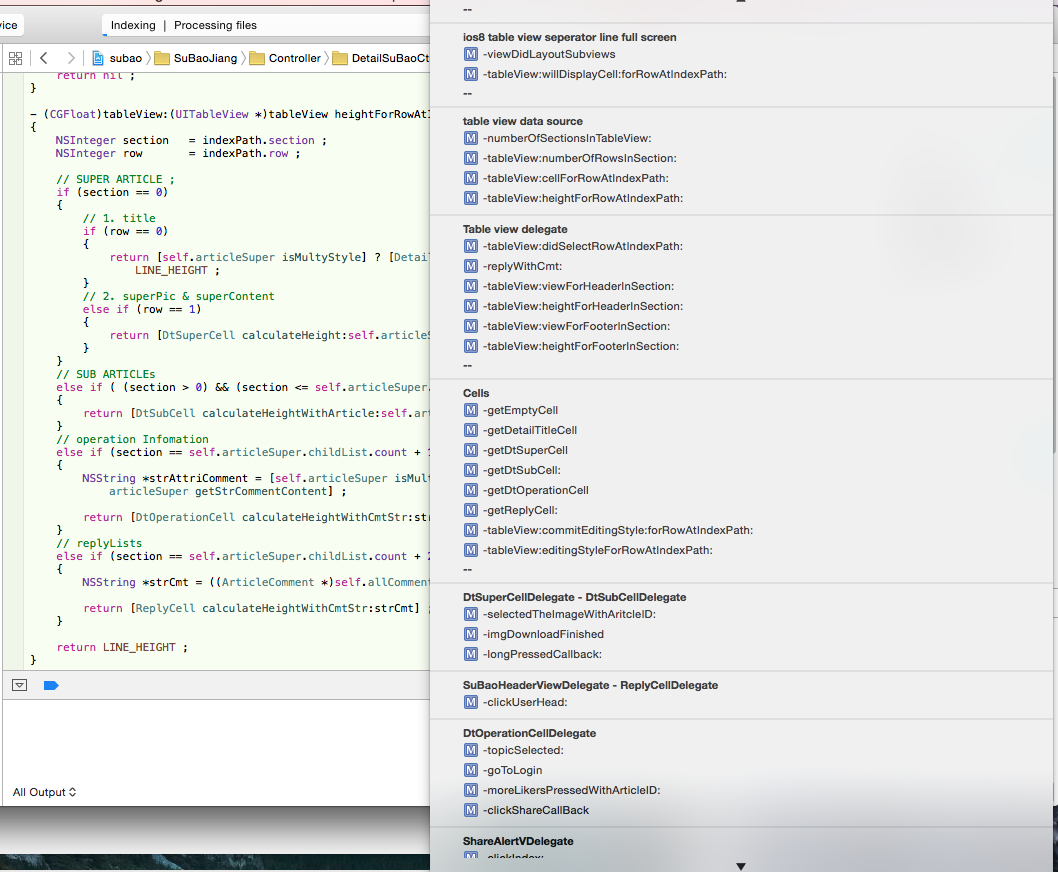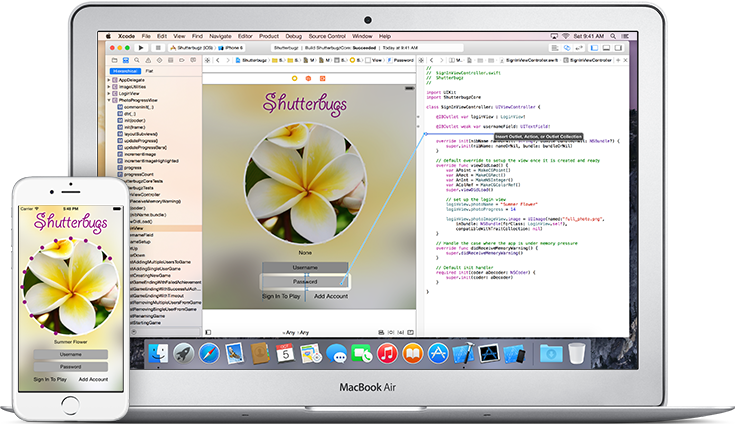不要把 ViewController 變成處理 tableView 的垃圾桶

請支持原創, 如需轉載, 請注明出處@TEASON
說在前面:
最近有個MVVM模式非常火熱, 相信它的出現是為了模塊化iOS開發, 其實在我看來,它始終還是MVC模式, 只是一個變種罷了 .(當然有人用到了響應式編程的思路顛覆了常規 , 但我們今天把討論點集中於代碼的設計模式) .
與其專注於說明 MVVM 的來歷,不如讓我們看一個典型的 iOS 是如何構建的,並從那裡了解MVVM:
Typical Model-View-Controller setup
我們看到的是一個典型的 MVC設置。Model呈現數據,View呈現用戶界面,而 View Controller調節它兩者之間的交互。
稍微考慮一下,雖然View 和 View Controller是技術上不同的組件,但它們幾乎總是手牽手在一起,成對的。你什麼時候看到一個 View能夠與不同 View Controller配對?或者反過來?所以,為什麼不正規化它們的連接呢?
Intermediate
這更准確地描述了你可能已經編寫的 MVC代碼。但它並沒有做太多事情來解決iOS應用中日益增長的重量級視圖控制器。在典型的 MVC 應用裡,許多邏輯被放在View Controller裡。它們中的一些確實屬於View Controller,但更多的是所謂的“用於顯示的邏輯”,以 MVVM 屬術語來說——就是那些從Model轉換數據為 View可以呈現的東西的事情,例如將一個NSDate 轉換為一個格式化過的 NSString。
我們的圖解裡缺少某些東西。某些使我們可以放置所有表示邏輯的東西。我們打算將其稱為“View Model”——它位於 View/Controller與 Model之間:
Model-View-ViewModel
看起好多了!這個圖解准確地描述了什麼是 MVVM:一個 MVC 的增強版,我們正式連接了視圖和控制器,並將表示邏輯從 Controller 移出放到一個新的對象裡,即 View Model。MVVM 聽起來很復雜,但它本質上就是一個精心優化的 MVC架構,而 MVC你早已熟悉。
好了, 引言說完了, 這是一個鋪墊 .
如果你認為下圖右邊的方法全部放在ViewController裡便於日後維護和擴展的話 . 你大可固執己見然後點擊浏覽器右上角的"×" ...

屏幕快照 2015-12-14 下午3.58.00.png
當然, 關於瘦身ViewController有很多方面 . 然而今天我們講講從Controller中分離TableView的表示邏輯 . 為什麼引言MVVM設計模式, 也是闡述這個主要思想是相通的 . 就是把"邏輯部分"盡量移到Model層, 你可以認為它是一個中間層 , 所謂"邏輯部分"可以是各種delegate,網絡請求,緩存,數據庫,coredata等等等等 , 而controller正是用來組織串聯他們 .使得整個程序走通 .
正文
我們很容易想到把 UITableViewDataSource和UITableViewDelegate 的代碼提取出來放到一個單獨的類.
但我發現還是有東西可以抽象出來 .
例如cell的生成, cell行高, 點擊等等 .這裡我還用了block的形式使得函數能夠回調 . 如果你對block還不太了解先看這裡 .
此外, 如果你也重度使用.xib生成Cell, 那和我封裝的類會非常契合 .
記住我默認習慣用.xib前的文件名來定義cell的Identifier. 如果你想把它用於實戰, 記得在xib設置cell的Identifier不要設錯.
處理類XTTableDataDelegate的.h
#import #import typedef void (^TableViewCellConfigureBlock)(NSIndexPath *indexPath, id item, XTRootCustomCell *cell) ; typedef CGFloat (^CellHeightBlock)(NSIndexPath *indexPath, id item) ; typedef void (^DidSelectCellBlock)(NSIndexPath *indexPath, id item) ; @interface XTTableDataDelegate : NSObject //1 - (id)initWithItems:(NSArray *)anItems cellIdentifier:(NSString *)aCellIdentifier configureCellBlock:(TableViewCellConfigureBlock)aConfigureCellBlock cellHeightBlock:(CellHeightBlock)aHeightBlock didSelectBlock:(DidSelectCellBlock)didselectBlock ; //2 - (void)handleTableViewDatasourceAndDelegate:(UITableView *)table ; //3 - (id)itemAtIndexPath:(NSIndexPath *)indexPath ; @end
注釋: //1. 初始化方法: 傳數據源, cellIdentifier, 三個block分別對應配置, 行高, 點擊 .
//2. 將UITableViewDataSource和UITableViewDelegate設於XTTableDataDelegate
//3. 默認indexPath.row對應每個dataSource .相應返回item
此外, 為了更徹底, 有必要抽象出"根Cell" .但這樣不利於擴展cell . 為了避開model和view的耦合. 所以使用category來做類的擴展 .
#import @interface UITableViewCell (Extension) + (void)registerTable:(UITableView *)table nibIdentifier:(NSString *)identifier ; - (void)configure:(UITableViewCell *)cell customObj:(id)obj indexPath:(NSIndexPath *)indexPath ; + (CGFloat)getCellHeightWithCustomObj:(id)obj indexPath:(NSIndexPath *)indexPath ; @end
故UITableViewCell+Extension, 通過類的擴展來實現新Cell .
注釋: //1 .不解釋.
//2. 根據數據源配置並繪制cell 子類務必重寫該方法
//3. 根據數據源計算cell的高度 子類可重寫該方法, 若不寫為默認值44.0
#pragma mark - Public
+ (void)registerTable:(UITableView *)table
nibIdentifier:(NSString *)identifier
{
[table registerNib:[self nibWithIdentifier:identifier] forCellReuseIdentifier:identifier] ;
}
#pragma mark --
#pragma mark - Rewrite these func in SubClass !
- (void)configure:(UITableViewCell *)cell
customObj:(id)obj
indexPath:(NSIndexPath *)indexPath
{
// Rewrite this func in SubClass !
}
+ (CGFloat)getCellHeightWithCustomObj:(id)obj
indexPath:(NSIndexPath *)indexPath
{
// Rewrite this func in SubClass if necessary
if (!obj) {
return 0.0f ; // if obj is null .
}
return 44.0f ; // default cell height
}那麼新cell類的實現如下: 實現兩個新方法
- (void)configure:(UITableViewCell *)cell
customObj:(id)obj
indexPath:(NSIndexPath *)indexPath
{
MyObj *myObj = (MyObj *)obj ;
MyCell *mycell = (MyCell *)cell ;
mycell.lbTitle.text = myObj.name ;
mycell.lbHeight.text = [NSString stringWithFormat:@"my Height is : %@", @(myObj.height)] ;
cell.backgroundColor = indexPath.row % 2 ? [UIColor greenColor] : [UIColor brownColor] ;
}
+ (CGFloat)getCellHeightWithCustomObj:(id)obj
indexPath:(NSIndexPath *)indexPath
{
return ((MyObj *)obj).height ;
}看下結果, 瘦身後的controller干淨的不像實力派, 只剩下了這一個方法 .呵呵呵呵 .
- (void)setupTableView
{
self.table.separatorStyle = 0 ;
TableViewCellConfigureBlock configureCell = ^(NSIndexPath *indexPath, MyObj *obj, XTRootCustomCell *cell) {
[cell configure:cell customObj:obj indexPath:indexPath] ;
} ;
CellHeightBlock heightBlock = ^CGFloat(NSIndexPath *indexPath, id item) {
return [MyCell getCellHeightWithCustomObj:item indexPath:indexPath] ;
} ;
DidSelectCellBlock selectedBlock = ^(NSIndexPath *indexPath, id item) {
NSLog(@"click row : %@",@(indexPath.row)) ;
} ;
self.tableHander = [[XTTableDataDelegate alloc] initWithItems:self.list
cellIdentifier:MyCellIdentifier
configureCellBlock:configureCell
cellHeightBlock:heightBlock
didSelectBlock:selectedBlock] ;
[self.tableHander handleTableViewDatasourceAndDelegate:self.table] ;
}諸多.m文件太過於冗長,我就不貼到博客了, 博客主要是講思路, 思路是王道 .
當然如果你想深入理解, 可以看源代碼, 我傳到了github, 點我下載 , 喜歡的話去那加個??, 對開源者是莫大的鼓勵 .
任何疑問或建議, 歡迎, 我會看你們的留言 .
介紹MVVM
Lighter View Controllers
Table View Programming Guide
Cocoa Core Competencies: Controller Object
- iPhone不要密碼看短信照片是真的嗎?蘋果不用密碼怎麼訪問照片短信[多圖]
- 蘋果iOS10准正式版體驗:一文告訴你全部亮點、要不要升級?
- 4個先例告訴你為什麼不要急於買iPhone6 Plus
- 要不要升級IOS8?不升級iOS8的六個理由
- iphone6屏幕要不要貼膜?
- IOS8不要將屏幕設置太亮
- ios8不要隨便更換屏幕貼膜
- iOS8.3下載免費應用不要密碼設置方法
- 蘋果iOS8.3下載免費應用不要密碼設置方法
- iOS 9要不要更新
- 不要浪費iPhone6 手機攝影基礎教程之學會用光
- iphone4s要不要升級iOS9?
- iPhone6/6 Plus要不要貼膜?
- IOS10要不要升級呢?
- 蘋果iOS10有哪些改變?要不要升級?




